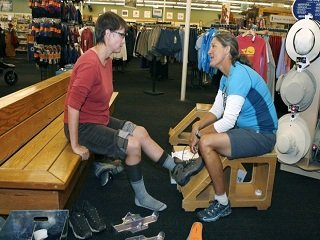 I know I sound like a broken record when I discuss what factors to consider when shopping for any new piece of equipment, but these things are vital components of an equation that will ensure that you walk out of the store with the best product for your needs. Whether it’s a backpack, tent, or boots, you can’t allow yourself to be distracted by costly features that you don’t really need, or groundbreaking design that doesn’t affect your activities. Shopping for hiking boots isn’t really that much different than shopping for a pair of tennis shoes, but there are a few things to take into consideration when it comes time to pick up a pair.
I know I sound like a broken record when I discuss what factors to consider when shopping for any new piece of equipment, but these things are vital components of an equation that will ensure that you walk out of the store with the best product for your needs. Whether it’s a backpack, tent, or boots, you can’t allow yourself to be distracted by costly features that you don’t really need, or groundbreaking design that doesn’t affect your activities. Shopping for hiking boots isn’t really that much different than shopping for a pair of tennis shoes, but there are a few things to take into consideration when it comes time to pick up a pair.
First and foremost, when shopping for hiking boots, you need to really think about your level of hiking. This means how often you hike, what type of terrain you’ll be walking on most, and whether you’ll be day hiking or embarking on long weekend trips. For example, large, ankle-cut hiking boots aren’t really necessary if you’re planning on a few brisk walks through the fields behind your house every now and then. If easy walks or day hikes are your style, then hiking shoes, which look like rugged tennis shoes, will work just fine for your needs. These shoes fit and feel like average athletic shoes, but have extra durability and treads to handle the trails. However, avid backpackers will want the extra padding and secure fit of hiking boots to counteract the added weight of a backpack and the strain it can have. Hiking boots are designed with extra layers of materials and treads at key areas to absorb shock, keep your center of gravity in balance, and prevent you from slipping when carrying a pack.
When you have some time, visit your local outdoor retailer and examine a few potential boots. Before you leave the house, though, don’t forget to wear the socks you’ll be wearing when you actually hike, or any in-soles or orthopedic inserts, as this will give you a better idea of what size shoe you’ll need. While you’re shopping, be sure to ask the associate any questions you may have. Try on a few different pairs and walk around with them in the store. If possible, I suggest taking a backpack with some weight inside for a test drive as well, in order to give you a better idea of what hiking with a full pack will feel like with your potential boots. When you’ve narrowed it down to two or three choices, I suggest heading home and checking the customer reviews on the models online. This will give you an idea of any common problems, if any, that customer have had with each boot in the past. If there are several complaints of components breaking or premature wear and tear, then take that into consideration.
Take your time and really get a feel for your boots before you make a purchase and do a bit of research on the models before you buy them. I’m a strong believer that shopping for hiking gear starts from the ground up, and finding a pair of boots that fits you comfortably, keeps you safe, and can handle what you plan on putting them through is very important.








